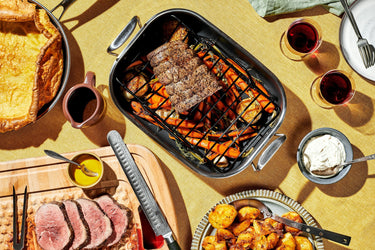How to Make a British-Inspired Sunday Roast

What comes to mind when you imagine Britain? Rainy weather in the summer? (Of course.) Humor drier than the Sahara? (Naturally.)
But when picturing British food, many Americans come up short. So we’re here to introduce you to the quintessentially British meal: the Sunday roast.
A time-honored tradition, the Sunday roast is a time when families and friends all over the British Isles gather over the weekend. Whether that’s at the local pub where everyone can pick their desired main (from roast beef to pork with cracklings and nut roasts for the veggies among us) or around a dinner table at home, there are few Brits who haven’t partaken in a classic Sunday roast.
Believed to have originated in the 15th century during the reign of Henry VII or possibly at the tables of serfs who’d performed well in battle practice, the origins of this meal are debatable. No matter: It doesn’t get in the way of this delicious meal, which may seem reminiscent of Christmas celebrations. In Britain, it’s eaten year-round, though perhaps with more gusto in the cooler months.
The Sunday Roast dinner is eaten anywhere from midday to early evening, which to many Americans might seem strange. Once you’ve tried your hand at this classic dish, however, you’ll be grateful to have a few hours to digest. Read on to learn more about this national treasure before making your own.
THESE ARE THE ESSENTIAL COMPONENTS OF A CLASSIC BRITISH SUNDAY ROAST:
- A large roast: The need for a piece of roast meat should perhaps come as no surprise. While beef is traditional (and the centerpiece of our own roast recipe), other meats are common on British dinner tables, from a large joint of lamb to pork with crackling skin to a roast chicken. English celebrity cook Sam Holland opts for beef for his own Sunday roast, if you're curious. Nowadays you might see a nut roast or a whole roasted cauliflower for vegetarians.
- Gravy: British gravy tends to be thinner than American gravy, which is either served alongside the roast or poured over top. You’ll want to make sure there’s enough for dipping your Yorkshire pudding into the sauce—it’s for more than garnishing the meat!

- Roasted vegetables: It’s not a roast without some roasted veggies cooked alongside the piece of meat. In our Sunday roast recipe, you’ll tuck carrots into the roasting pan to catch the beef drippings. Other common picks include parsnips and rutabaga (called swede in the UK). Brussels sprouts are a must-have for Christmas roasts, but you’re more likely to see kale or green beans throughout the year if you want something green alongside the roasted vegetables. Though peas are not essential, they are a welcome addition to the roast plate.
- Roasted potatoes: Good luck to the cook who serves a roast without crispy potatoes alongside. Our duck fat-roasted potatoes are an exemplary version of the essential dish, dare we say. There are a few keys to making perfect British roasted potatoes: You’ll start by boiling peeled chunks of potato until tender. After draining and returning them to the pot, you’ll “rough them up,” aka shake them around a bit so the edges become a bit floury. This helps get a craggy, crispy crust in the oven. Next, you’ll heat the duck fat on a large rimmed baking sheet before adding the potatoes. This ensures they start cooking right away rather than soaking up the fat. Finally, you’ll let them roast for a good long time so they become adequately golden. For best order of operations, we recommend roasting the potatoes before you start the meat and keeping them covered in an oven safe dish. Then, reheat them once the Yorkshire pudding comes out of the oven and you slice the meat.
- Yorkshire pudding: Arguably “young” when compared to the roast meat tradition, the Yorkshire pudding was first recorded in the 18th century in the northern county of Yorkshire. Making it is unbelievably simple—just whisk together the ingredients, pour into a piping hot, greased tin, and bake it. Originally the pudding was baked in the drippings of the roasted meat, but today it’s cooked in a specific tin that resembles a muffin tin but has deeper wells. This helps the puddings achieve their characteristic height. Our recipe offers something a bit easier than dividing the batter between the individual wells. Instead, you’ll use your HexClad 12" Hybrid Fry Pan to make a single, gorgeous Yorkshire pud.

- Cauliflower cheese: Few things are more decadent than cauliflower cheese, which draws cauliflower in a bechamel and tops it with a shower of rich cheese like gruyere. Head over to our UK site to get our bacon-flecked version of cauliflower cheese (with a touch of kale for good measure).
We haven’t forgotten dessert! A classic pick is sticky toffee pudding with a butterscotch sauce poured over top, but a steamed pudding or apple crumble would be welcome, too.
Does this all sound like quite a lot of work? HexClad contributing recipe developer Bee Berrie suggests inviting some friends to help cook or asking people to bring one of the side dishes. Berrie loves bitter—a cloudy beer from the north of England—and for the NA folks, a tangy drink called St. Clements made with orange juice and lemonade.
Enjoy the roast, and even better, enjoy the delicious leftovers throughout the week!





